AQA GCSE Geography - The Changing Economic World
1/102
There's no tags or description
Looks like no tags are added yet.
Name | Mastery | Learn | Test | Matching | Spaced |
|---|
No study sessions yet.
103 Terms
What is 'development'?
- the progress in economic growth, use of technology, and improving welfare that a country has made
- when a country develops, the residents' quality of life improves
What is the 'global development gap'?
- the difference in development between more and less developed countries
What does 'GNI' mean?
- gross national income
- the total value of goods and services produced by a country in a year, including income from overseas
- often given in US$
- it is a measure of wealth and as a country develops, their GNI gets higher
What is 'GNI per head'?
- the GNI divided by the population of a country
- sometimes called 'GNI per capita' (per person)
What is 'birth rate'?
- the number of live births per thousand of the population per year
What is 'death rate'?
- the number of deaths per thousand of the population per year
- its a measure of the countries health
- it gets lower as the country develops
What is 'infant mortality rate'?
- the number of babies who die before they are 1 year old, per thousand babies born
What is 'people per doctor'?
- the average number of people for each doctor
- as a country develops, it gets lower as there are more doctors available so less people are assigned to one doctor
What is 'literacy rate'?
- the percentage of adults who can read and write
- a measure of education
- as a country develops, it gets higher
What is 'access to safe water'?
- the percentage of people who can get clean drinking water
- a measure of health
What is 'life expectancy'?
- the average age a person can expect to live to
- as a country develops, the life expectancy gets higher as people have access to potable water, good medicine, etc
Why is 'GNI per capita' misleading?
on its own because it is an average so variations within a country do not show up and anomalies are still used
Why are some social indicators and measures of development misleading?
- these can be misleading if used on their own because, as a country develops, some aspects develop before others so it might seem like a country is more developed than it actually is
Why may a country's GNI be inaccurate?
- GNI usually misses out informal employment, which can account for a large proportion of national income
- informal employment is the part of any economy that is neither taxed nor monitored by any form of government
What is the difference between LICs, HICs and NEEs?
- these are the most common ways of classifying a country's level of developnent (by looking at its wealth)
- higher income countries are the wealthiest in the world, where the GNI per head is high
- lower income countries are the poorest in the world, where the GNI per head is very low
- in newly emerging economies, the welath does not stay the same but instead, these countries are rapidly getting richer as their economy moves from being based on the primary industry to the secondary industry
Give four examples of HICs.
- UK
- USA
- Canada
- France
Give three examples of LICs.
- Afghanistan
- Somalia
- Uganda
Give nine examples of NEEs.
- the BRICS
=> Brazil
=> Russia
=> India
=> China
=> South Africa
- the MINT countries
=> Mexico
=> Indonesia
=> Nigeria
=> Turkey
What is 'HDI'?
- the Human Development Index is a combination of different measures and it tells you about both the country's level of economic development and the quality of line for people who live there
How is HDI calculated?
- calculated using income (GNI per head), life expectancy and educational level (eg avg years of schooling)
- every country has a HDI value between 0 (least developed) and 1 (most developed)
What does the Demographic Transition Model show?
- the DTM shows how birth rates and death rates affect population growth
- when the birth rate is higher than the death rate, the population grows (natural increase)
- natural decrease is when the death rate > the birth rate
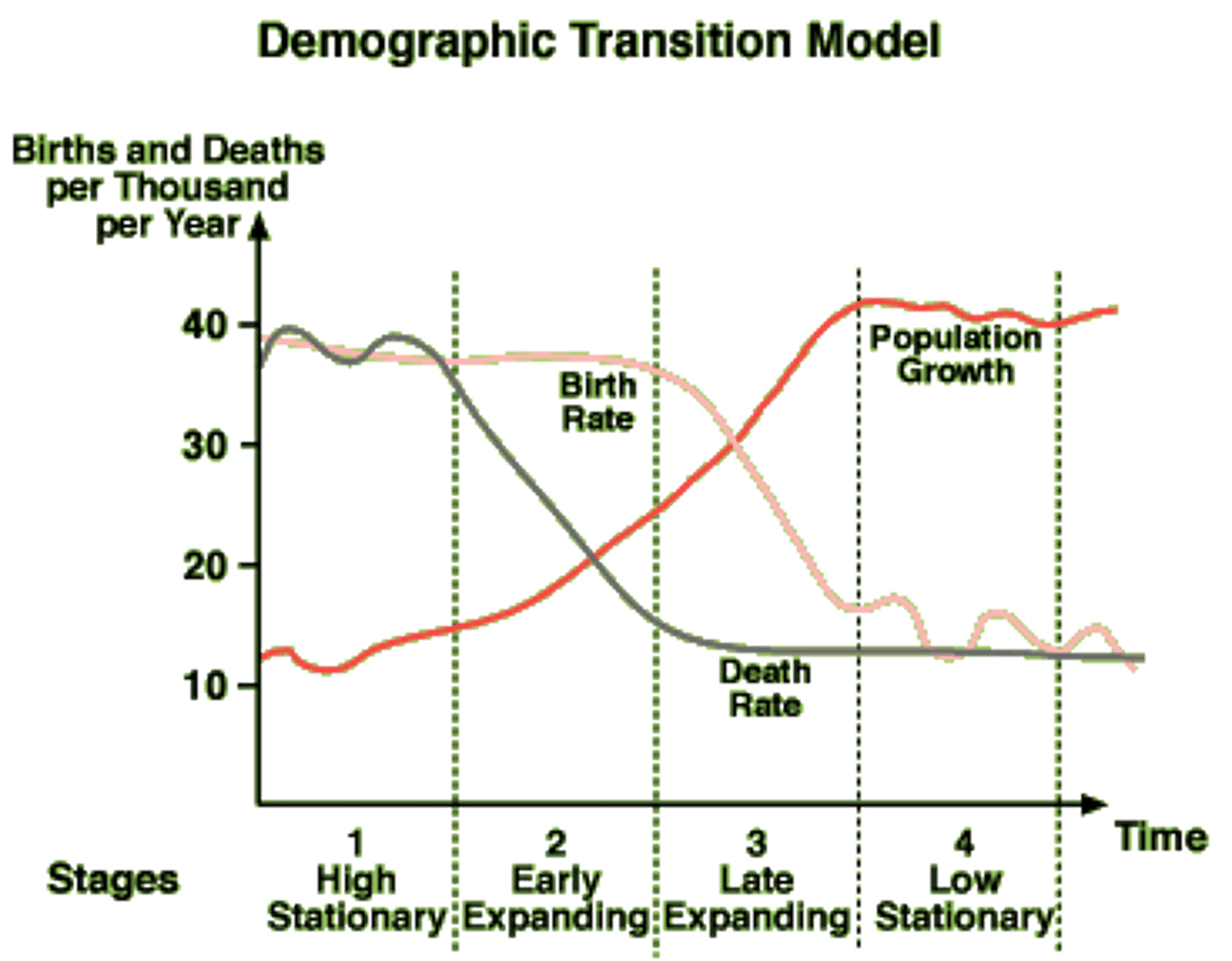
What happens during Stage 1 of the DTM?
-least developed
-High DR
-High BR
-Pop. steady
e.g. Tribes
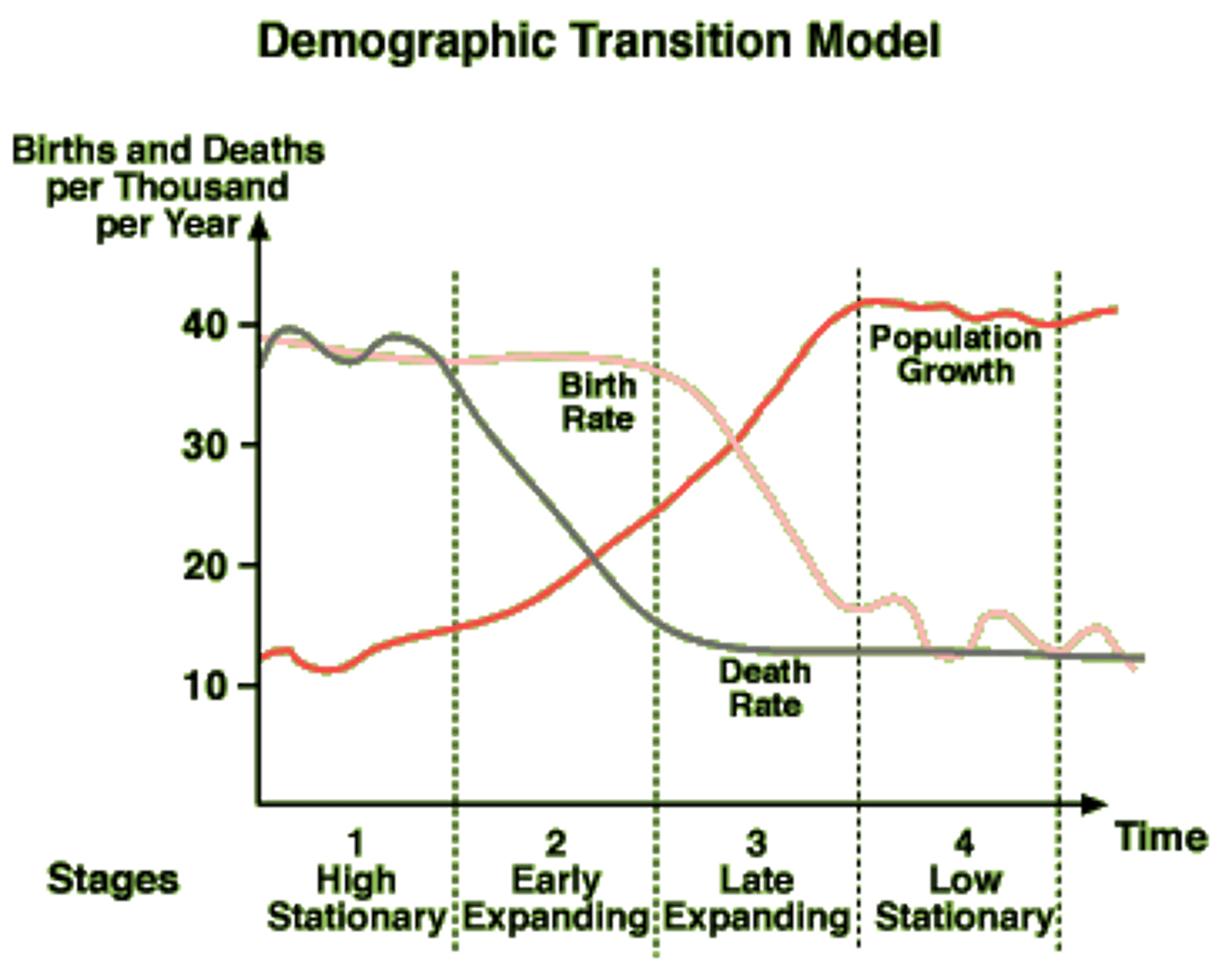
What happens during Stage 2 of the DTM?
- still not very developed
- low BR
-Declining DR
-Very High pop.
e.g. Jamaica
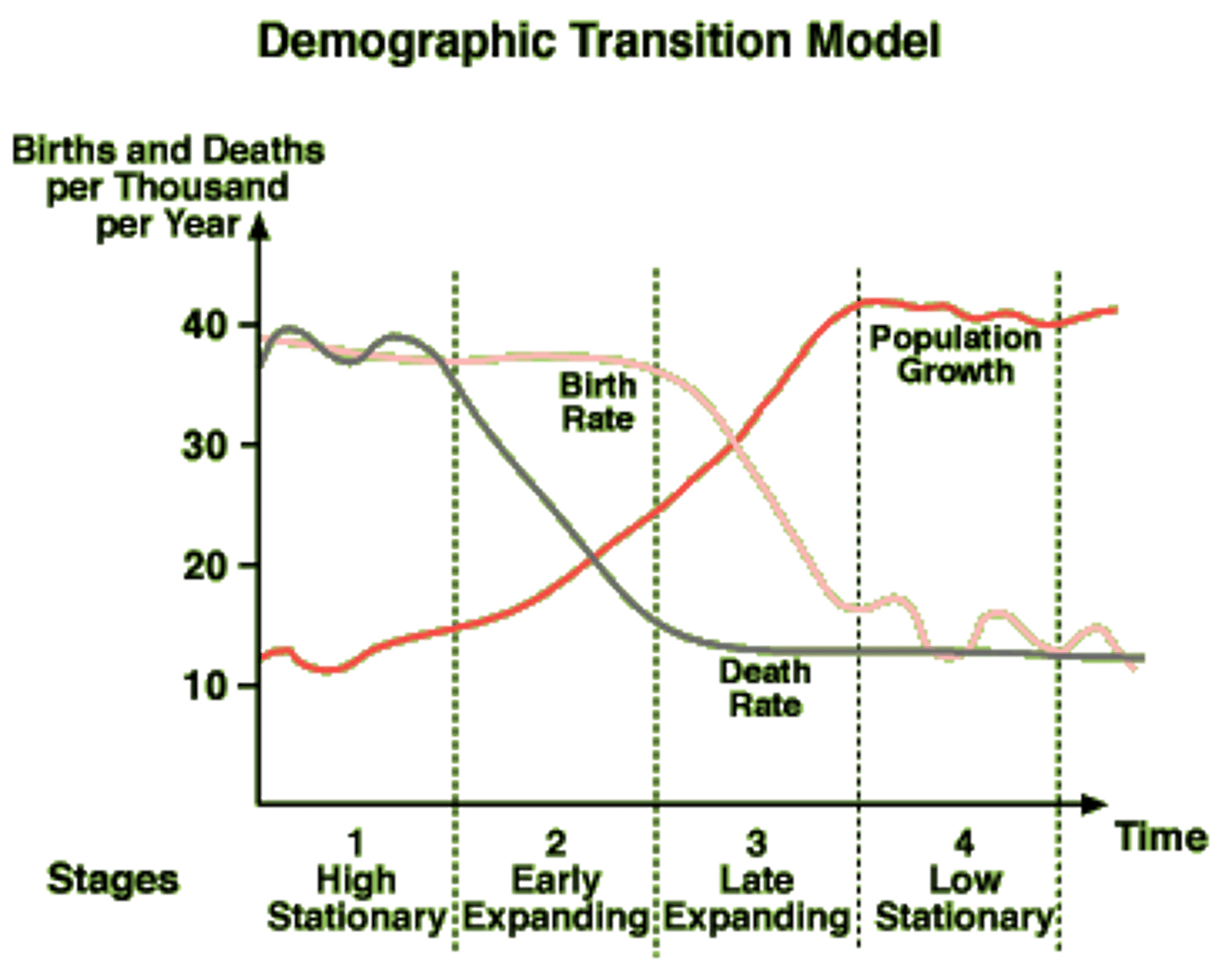
What happens during Stage 3 of the DTM?
- Rapidly falling DR
-Low BR
- High pop.
e.g. Nigeria
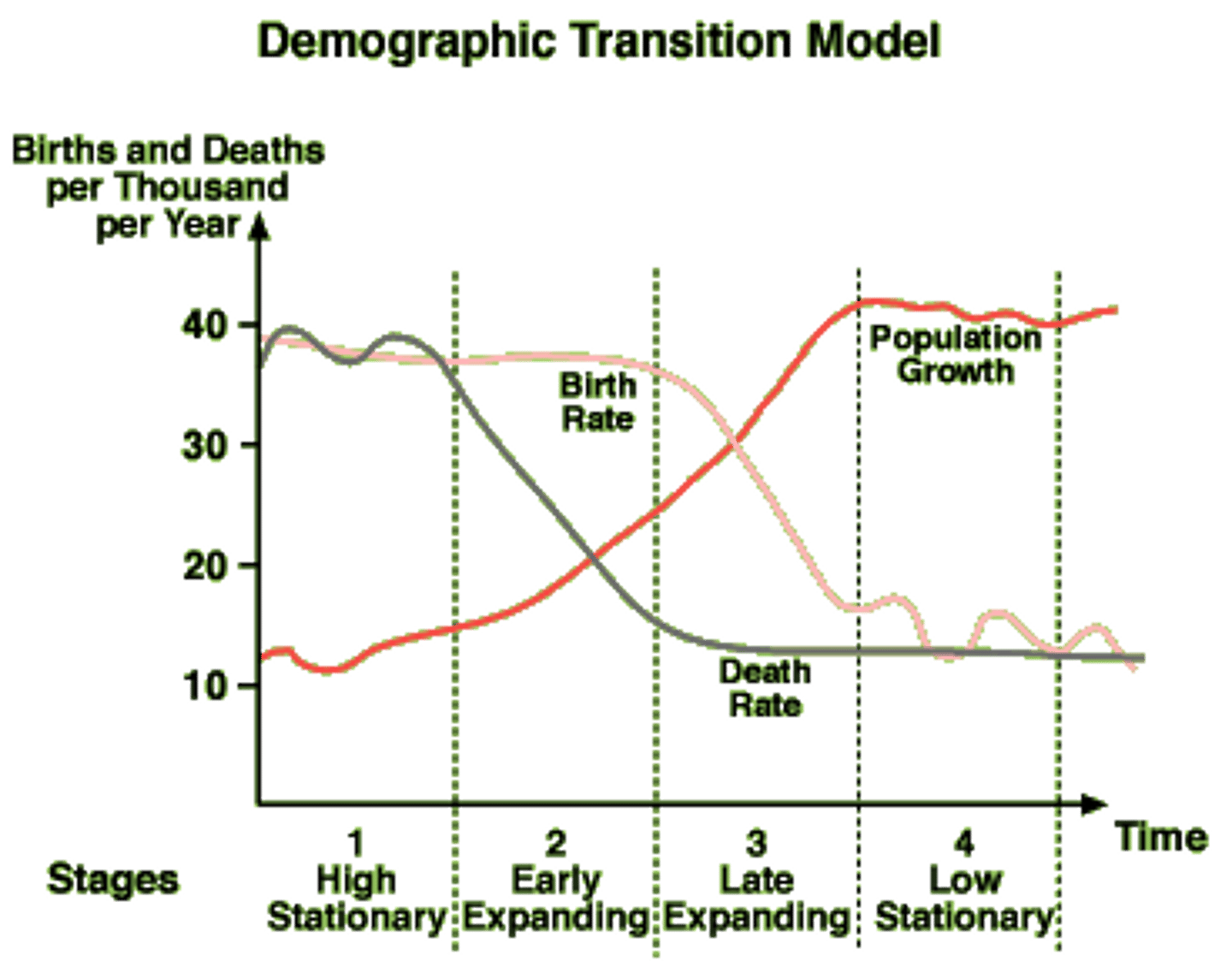
What happens during Stage 4 of the DTM?
- Slowly falling DR
- Low BR
- steady pop.
e.g. UK
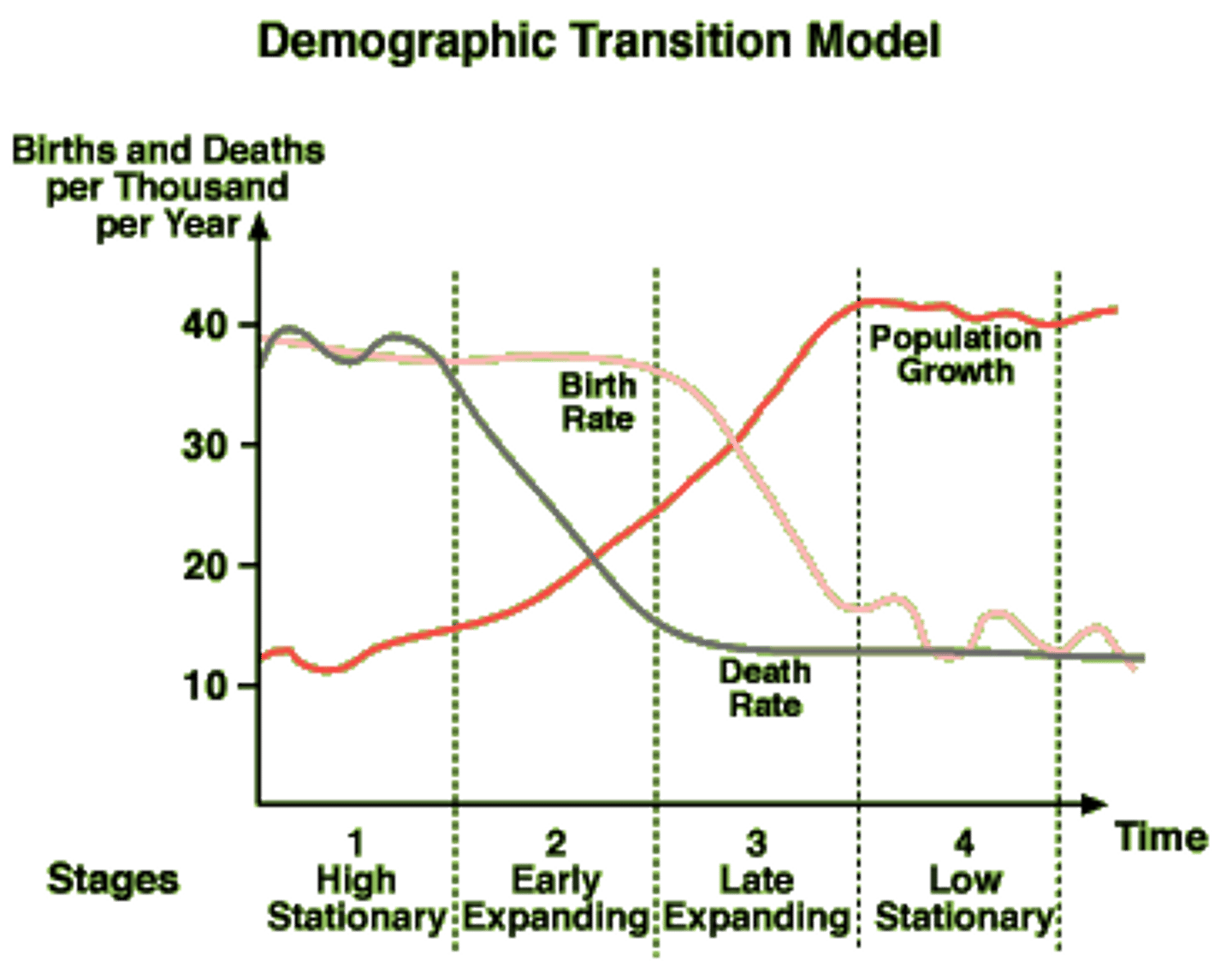
What happens during Stage 5 of the DTM?
- Slowly falling DR
- Low BR
- Falling Pop.
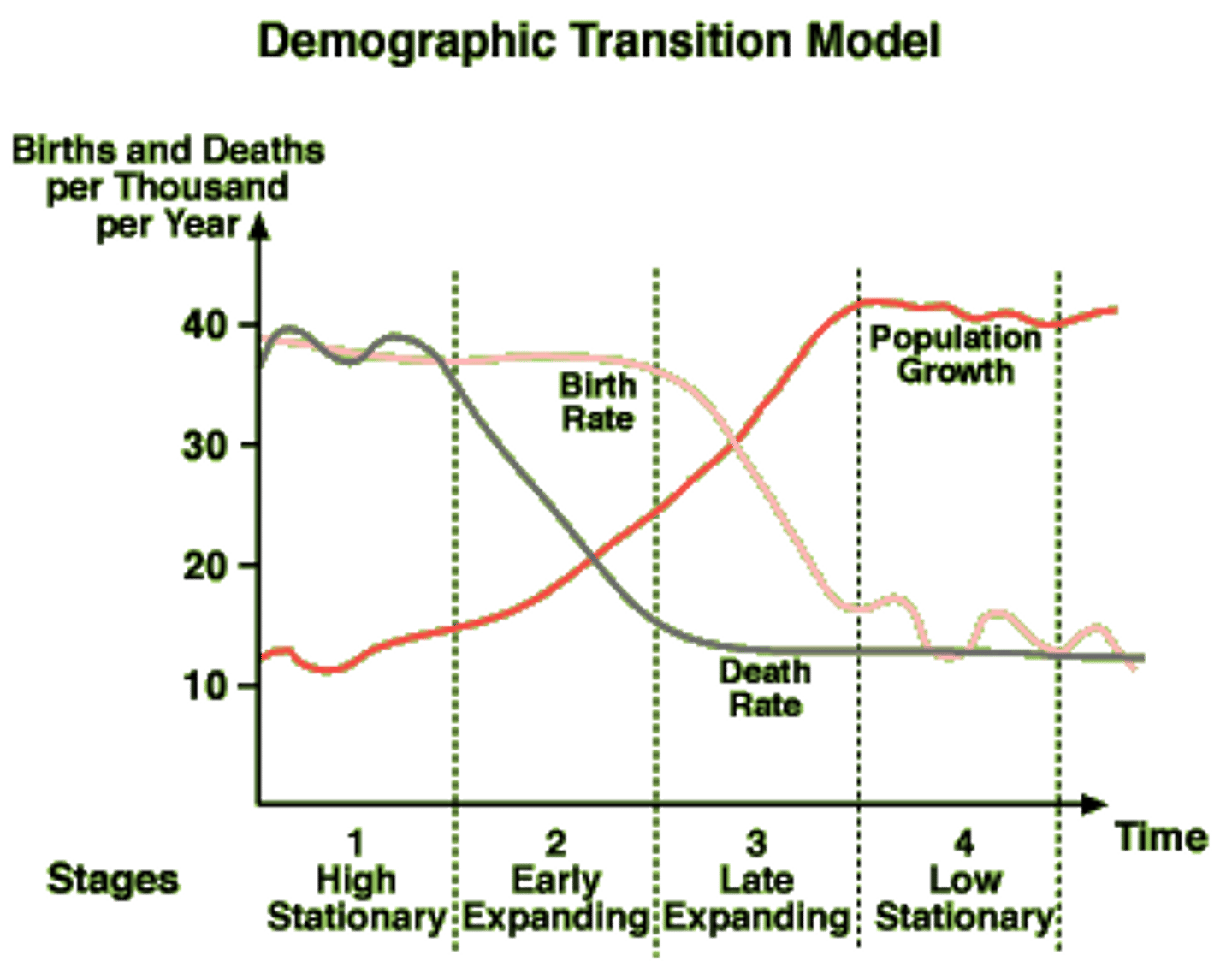
How is having a poor climate a physical factor that causes uneven development?
- some countries have a really hot, really cold, or really dry climate where not much will grow => not much food can be produced => malnutrition (eg Chad and Ethiopia) => low quality of life
- people also have fewer crops to sell => less money to spend on goods and services => less is sold and bought => government gets less money from taxes => less money to spend on developing the country (eg by improving healthcare and education)
How is having poor farming land a physical factor that causes uneven development?
- if land in a country is steep or has poor soil (or no soil) => difficult to grow crops or graze animals to produce food => safe effects as having a poor climate
How is having few raw materials a physical factor that that causes uneven development?
- countries without many raw materials (eg coalm oil or metal ores) have fewer products to export to other countries => make less money => unable to spend much on development projects
- some developing countries have a lot of raw materials but cannot afford to develop the infrastructure needed to exploit them (eg roads and ports)
How is having lots of natural disasters a physical factor that causes uneven development?
- countries that have a lot of natural disasters (eg Bangladesh, which often has floods) have to spend a lot of money rebuilding after the disasters occur
- natural disasters reduce the quality of life of the people affected, and reduce the amount of money the government can spend on development projects
How is having poor trade links an economic factor that causes uneven development?
- if a country has poor trade links (only trades a small amount with only a few countries), it won't make a lot of money => less to spend on development
How is having lots of debt an economic factor that causes uneven development?
- very poor countries borrow money from other countries and international organisations (eg to help cope with the aftermath of a natural disaster) => this money has to be paid back (sometimes with interest) => less for development
How is having an economy based on primary products an economic factor that causes uneven development?
- countries that mostly export primary products (raw materials like timber and metal) tend to be less developed than countries that export manufactured goods because primary products are sold for less profit than manufactured goods
- the prices of primary products also fluctuate (sometimes the price falls below the cost of production) => no profit is made
- wealthy countries can also force down the prices of the raw materials they buy from poorer countries
How is colonisation a historical factor that causes uneven development?
- countries that were colonised (ruled by another country) are often at a lower development level when they gain independence than they would be if they hadn't been colonised
- European countires colonised many countries in Asia, Africa, Australasia and the Americas between the 16th and 20th centuries
- the colonisers removed raw materials and sold back manufactured goods => profit went to the colonisers rather than the colonised countries, increasing inequality
- prevented the colonised countries from developing their own industries
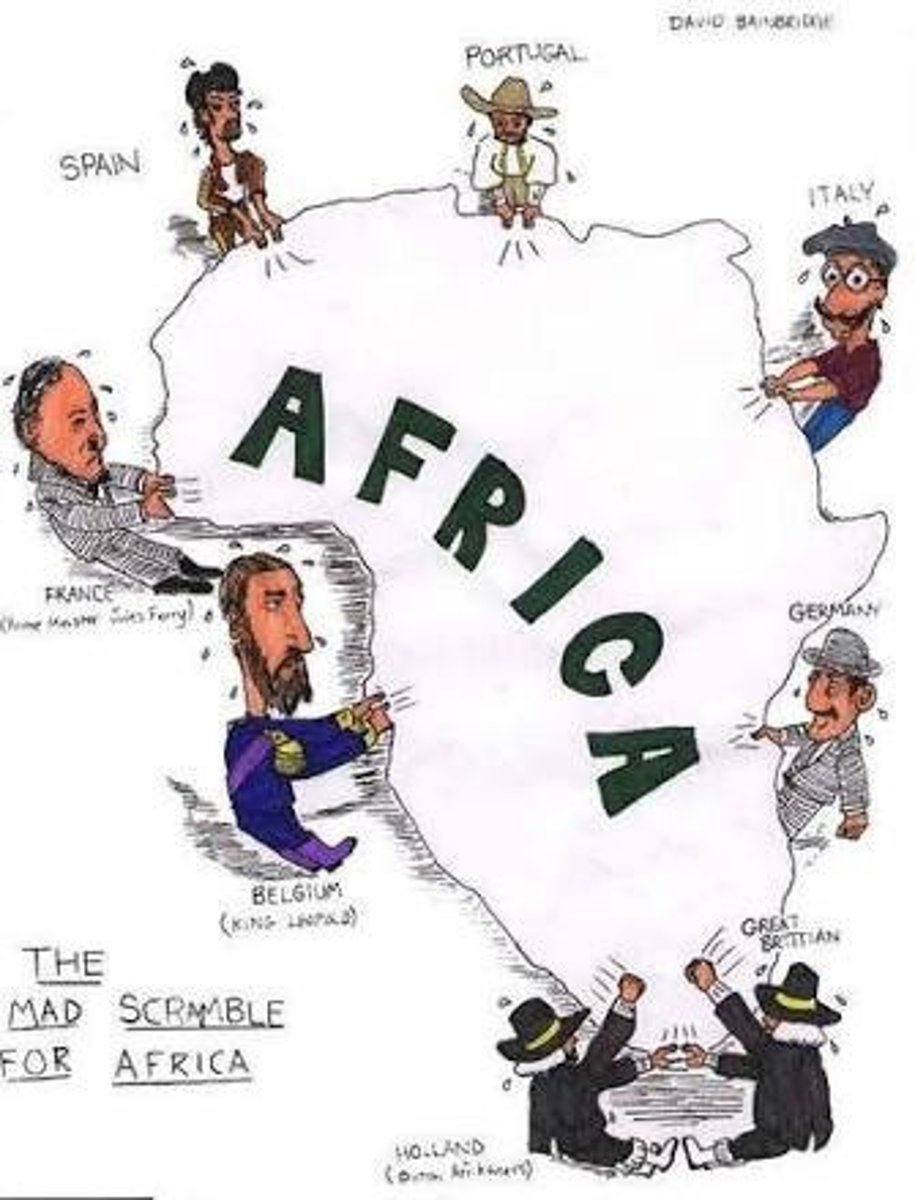
How is conflict a historical factor that causes uneven development?
- war, especially civil war, can slow or reduce development, even after the war is over
- money is spent on arms and on training soldiers instead of development; people are killed and damage is dealt to infrastructure and property
- important services, such as, healthcare and education, are disrupted => increase in infant mortality rate and a decline in literacy rate
- eg in 2008, Syria had a HDI value of 0.65 but in 2016, after 5 years of war, this had dropped to 0.54
How are disparities in wealth a consequence of uneven development?
- people in more developed countries have a higher income than those in less developed countries (eg GNI per head in the UK is over 40 times higher than in Chad)
- uneven developement can also lead to big inequalities in wealth within countries (eg in 2017, the richest 10% of Kenya's population earned, on average, 23x more than the poorest 10%)
- wealth can impact people's standard of living; the wealthy can afford goods and services that make their live more comfortable and convenient (eg cars)
How are disparities in health a consequence of uneven development?
- healthcare in more developed countries is usually better than in less developed countries
- people in HICs live longer (eg the UK's life expectancy is 81, but in Chad, it's only 53)
- infant mortality is much higher in less developed countries (eg it's 73 per 1000 births in Chad, compared to the UK's 3.7 per 1000 births)
- in LICs and NEEs, the lack of adequate healthcare can mean people die from diseases that could be easily treated in HICs (in 2016, diarrhoea is estimated to have killed over 1.4million people in South Asia and sub-Saharan Africa
How is international migration a consequence of uneven development?
- many people from LICs and NEEs move to HICs to escape conflict or to improve their quality of life
- eg >130,000 people from Mexico (an NEE) to the USA (an HIC) legally each year (and thousands more enter illegally) in search of better paid jobs and a higher quality of life
- migrant workers contribute to the economies of the HICs they move to instead off the LICs they leave from, which further increases the development gap
How can investment reduce the global development gap?
- foreign-direct investment (FDI) is when people or companies in one country buy property or invest in infrastructure in another country
- FDI leads to better access to finance, technology and expertise, as well as improved infrastructure and industry, and an increase in services
- eg betwenn 1987 and 2018, Vietnam received FDI worth more than US $182billion, which helped to develop many industries, such as, motorbike manufacturing and telecommunications
How can industrial development reduce the global development gap?
- in countries with a very low level of development, agriculture makes up a large portion of the economy
- developing industry boosts GNI and development, as productivity, skills and infrastructure are improved
How can aid reduce the global development gap?
- money or resources (eg food, medicine) are given to a couuntry by a charity or foreign government
- the money is used for development projects (eg for constructing schools, building dams and wells and providing farming knowledge and equipment)
- eg in 2018-19, the UK provided over £180million in aid to South Sudan, funding 17 projects that included improving access to water, healthcare and education
- aid can definitely help, but sometimes, it is wasted by corrupt governments
- or one the money runs out, projects can stop working if there isn't enough local knowledge and support
How can the use of intermediate technology reduce the global development gap?
- intermediate technology includes tools, machines and systems that improve quality of life but are alos simple to use, affordable to buy or build and cheap to maintain
- eg solar-powered LED lightbulbs are used in parts of Nepal where the only other lighting options are polluting and dangerous kerosene lamps or wood fires
- this allows people to work and children to study after work
=> as a result, skills, incomes and industrial output can increase
How can fair trade reduce the global development gap?
- the fair trade movement is all about farmers in LICs getting a fair price for the goods they produce, eg coffee and bananas, allowing them to provide for their families
- companies who want to sell products labelled as 'fair trade' have to pay producers a fair price
- buyers pay extra on top of that so that farmers receive a premium to help develop their local area (eg in 2016, Fairtrade tea farmers in Malawi used some of their premium to expand their local hospital, build a new school and install a pipeline for clean water
- however, there are problems: in some cases, only a tiny proportion of the extra money reaches the producers, while the rest boosts retailers' profits
How can debt relief reduce the global development gap?
- debt relief is when some or all of a country's debt is cancelled, or interest rates are lowered, meaning the country has more money to spend on development
- eg Zambia had $4billion of debt cancelled in 2005 and in 2006, the country had enough money to start a free healthcare scheme for millions of people living in rural areas
How can microfinance loans reduce the global development gap?
- microfinance is when small loans are given to people in LICs who may not be able to get loans from banks => this enables them to start their own businesses and become financially independent
- eg in the Amhara region of Ethiopia, people who joined a microfinance organisation benefited from higher incomes and were able to invest in more livestock
- although microfinance works for some people, it can also cause problems by encouraging people to get into debt
- it's also not clear that it can reduce poverty on a large scale
What is Kenya's government trying to boost in order to increase its development?
What has Kenya done to boost this?
What was the effect of these actions?
- Kenya is an LIC in East Africa
- it attracts tourists because of its culture, safari wildlife, warm climate and unspoilt scenery
- Kenya's government is trying to boost tourism to increase development, eg:
=> visa fees for adults were cut by 50% in 2009 to make it cheaper to visit the country (they were also scrapped for children under 26 to encourage more families to visit)
=> landing feeds at airports on the Kenyan coast have been dropped for charter airlines
===> tourism increased from 0.9million visitors in 1995 to 1.4million in 2017
What are the benefits of a growth in tourism for Kenya?
- tourism now directly contributes nearly 4% of Kenya's GDP; money that can be spent on development and improving quality of life (since 2000, Kenya's HDI value has increased from 0.45 to 0.59)
- over 1.1million people are directly or indirectly employed by the tourism industry (9% of all employment in Kenya)
- businesses and Kenya's government have invested in transport infrastructure to encourage more tourists tto visit, which can also benefit local people (eg the new Madarak Express railway links Kenya's capital, Nairobie, to the coast => this has created jobs, halved journey times and made it chaper for people to travel)
- the 24 national parks charge entry fees to tourists => this money is used to maintain the national parks => this helps to protect the environment and wildlife, so tourists keep visiting
What are the cons of a growth in tourism for Kenya?
- only a small proportion of the money earned goes to locals; the rest goes to big companies, often based in HICs, so it doesn't help to close the development gap
- some Maasai communities have been forced off their land to create national parks and game reserves for tourists
- tourist vehicles damage the environment by destroying vegetation and disturbing animals
- in recent years, tourist numbers have fluctuated, especially followingg terrorist attacks in Kenya => this means that tourism isn't a reliable source of jobs and income
Where is India located?
- country in South Asia
- southeast of Pakistan
- southwest of Nepal and China
- north of Sri Lanka
- east of the Arabian Sea
- west of Bangladesh
- northwest of the Bay of Bengal
Why is India a significant country in the world?
- India is a rapidly developing NEE
- it has the second largest population in the world (~1.3billion) and is still growing
How is India important regionally?
- has the biggest population and economy in South Asia so it plays a major role in trade and politics in the region
- India's position in the Indian Ocean has also allowed it to establish trade links with south east Asia and the Middle East
How is India important globally?
- India is increasingly important gglobally; it exports services (eg IT support) and manufactured goods (eg medicine) across the world
- it's a member of the World Trade Organisation
- also a member of the G20 (a group of 20 of the world's largest economies)
What is the wider political context of India?
- India was a British colony until 1947 but now has a democratically elected government
What is the social context of India?
- India has a medium level of development (HDI=0.64)
- there are large inequalities; some people are very wealthy but the majority are poor, and over 20% of the population live in poverty
- education is improving but the adult literacy rate is still less than 75%
What is the cultural context of India?
- India has a rich and diverse culture
- it has over 22 officially recognised languages and is home to followers of manu major religions, including Hinduism and Islam
- it's also renowned for its production of 'Bollywood' films, which are exported worldwide, and for its distinctive music and dancing styles, eg Bhangra
What the environmental context of India?
- India has a varied landscape, including the Himalayas in the north, the Thar desert in the northwest, and large areas of forest
- the floodplains of several major rivers, such as the Ganges and the Indus, provide fertile farmland
- India also has a long coastline, making it an attractive tourist destination and has allowed the development of ports, such as Mumbai, increasing trade
What is the balance between the four industries in India, and how are these proportions changing?
- primary industry (eg agriculture) employs 42% of the working population, but it is becoming a smaller part of India's economy; it makes up only 15% of the GDP
- secondary industry (manufacturing) has grown rapidly; it 1999, it only employed 16% of the workforce, whereas by 2018, it employed 24% of the workforce
- tertiary (service) and quaternary (knowledge) industries have become a much larger part of the economy, employing 34% of the workforce
- lots of this is due to growth in IT firms (especially in Bengaluru) and in supplying services for foreign companies, such as customer service centres
- tertiary and quaternary industries contribute the most to India's GDP, 62%

How has the growth of manufacturing industries stimulated economic development?
- they have provided people with reliable jobs (compared to seasonal agricultural work)
- employment can lead to a positive cycle of economic growth, as workers spend their income in local shops and other businesses; these businesses pay taxes, allowing the government to spend more on development, eg education and infrastructure, which attracts more industry to the area
- eg in Hyderabad, the government has constructed new business districts and townships to attract industry
- in 2018, the city has one of the fastest growing economies in the world
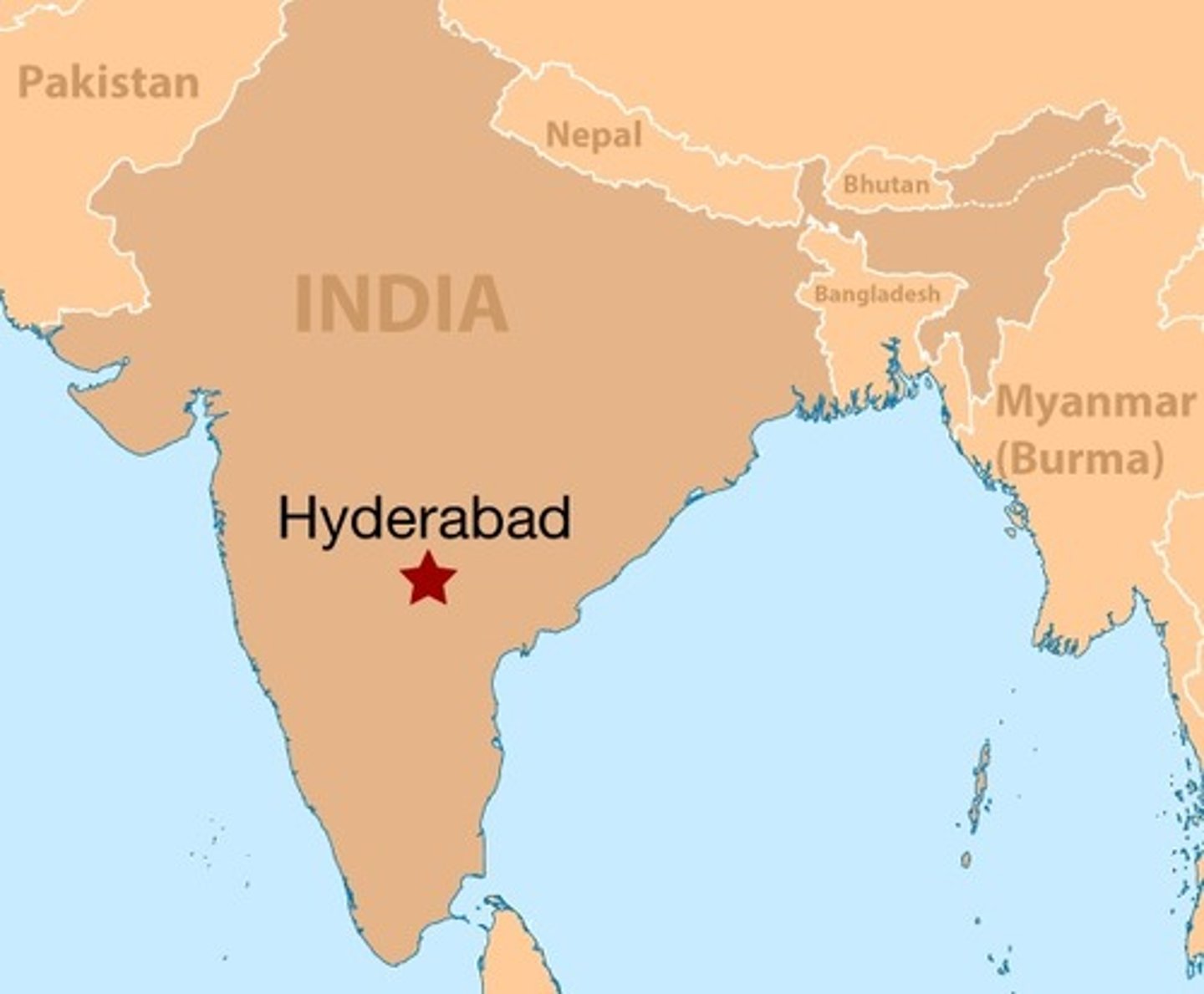
What are 'transnational corperations'?
- TNCs are companies that operate in more than one country
What is the role of transnational corporations (TNCs) in relation to industrial development in India?
- TNC factories are usually located in LICs because labour is cheaper, and there are fewer environmental and labour regulations, which means they make more profit
- TNC offices and headquarters are usually located in HICs because there are more people with administrative skills (because education is better)
- many TNCs operate in India, including Unilever, one of the world's biggest food and consumer goods manufacturers (Hindustan Unilever Ltd is its Indian division)
What are the advantages of TNCs for India?
- TNCs provide employment (eg Unilever employs over 16,000 people in India)
- TNCs have to pau tax of about 40% of their income to the Indian government (eg Hindustan Unilever Ltd has annual sales of over $5billion, so its taxes make a significant contribution to the government's income)
- some TNCs run programs to increase development in India (eg Unilever's Project Shakti) helps poor women in rural areas become entrepreneurs by providing loans and products for them to sell; there are now ~75,000 women in the scheme; Unilever has also worked with chartities to improve sanitation for over 140million people in India
What are the disadvantages of TNCs for India?
- some profits from TNCs leave India (eg Unilever is a Dutch-British company)
- TNCs may close operations in LICs and NEEs, causing job losses; TNCs may also decide to relocate factories to a different area of the country to take advantage of local government incentives (eg tax breaks), so jobs can be unreliable
- some TNCs, eg fashion brands whose clothes are manufactured in India, have been criticised because their employees receive low pay and have poor working conditions
How is India's political relationships with the wider world changing?
- Pakistan and China both disagree with India over who owns some of the land on the border => this has led to tension between the three countries and increased the risk of conflict
- India has built relationships with other nations in the region, eg by developing the Act East policy to increase its influence in southeast Asia and provide security for the region
- India is also working with its neighbours to build the TAPI pipeline to carry natural gas from Turkmenistan, through Afghanistan and Pakistan to India
How is India's trading relationships with the wider world changing?
- trade is increasingly important to India's economy; the government limits imports and exports but since 1991, they have reduced barriers to trade by reducing tariffs (mostly taxes on imported goods) and forming free trade agreements, such as the Asia-Pacific Trade Agreement with Bangladesh, China, South Korea and Sri Lanka
- TNCs account for a large proportion of global trade, so more foreign companies start up in India (and Indian TNCs start up elsewhere), India's trade increases
- eg in 2014, over 3000 foreign companies were operating in India; between 2005 and 2015, foreign direct investment in India increased from US$7.3billion to US$44billion
What is 'short-term aid'?
- when money and supplies are given to help countries cope with emergencies
What is the impact of short-term aid on India?
- it helps people survive disasters but doesn't help long-term recovery
- eg in 2010, floods affected over 1.7milliom people in northern India; UNICEF provided emergency supplies, including water purifying tablets and mosquito nets
What is 'long-term aid'?
- money is invested in longer-term projects to help countries become more developed
What is the impact of long-term aid on India?
- it can help India's long-term development, eg by improving infrastructure or education; however, India has had problems with corrupt officials misusing it
- eg until 2015, the UK sent £200million a year to India to improve education, healthcare and sanitation in the poorest areas
What is 'top-down aid'?
- an organisation or the government decides how aid should be used
What is the impact of top-down aid on India?
- projects can improve the country's economy but may not help the poorest people or be supported by local people
- eg the Sardar Sarovar Dam in Gujarat provides water for drinking and irrigation and generates HEP but its construction displaced over 300,000 people
What is 'bottom-up aid'?
- money or supplies are given directly to local communities so they can decide how to use the aid by themselves
What is the impact of bottom-down aid on India?
- projects provide help where it is needed most, so they can improve health, skills and income in poor communities
- eg the Self-Employed Women's Association (SEWA) has trained local women to maintain and repair water pumps in Gujarat, increasing their skills and improving water supply
How has economic development in India impacted the quality of life of its residents?
- there are more jobs, and daily wages have increased by ~42Rs; people have more money to improve their life, eg by securing access to clean water
- between 1990 and 2008, access to clean water increased from 68% of the population to 88%; since 2000, HDI has increased from 0.49 to 0.64
- however, some jobs in industry, eg coal mining, can be dangerous or have poor working conditions, which can reduce workers' quality of life
How has economic development in India impacted the environment?
- India's energy consumption has increased with economic development; fossil fuels like coal and oil are the most readily available and affordable fuels, but release lots of pollution and greenhouse gases; the capital, Delhi, has the worst pollution in the world
- demand for resources can lead to the destruction of habitats, eg coal mining in Maharashtra has damaged the habitats of Bengal tigers
- increased income from economic development means people can afford to protect the environment rather thn exploiting it unsustainably; eg since 1990, India's forest cover has stopped decreasing and started to grow
How is the UK's economy changing?
- economy used to be based on manufacturing but since the 1960s, manufacturing has declined, and tertiary and quaternary industries have grown
- in 2017, these industries employed 83% of the UK's workforce, and this proportion is increasing
What are the four most important industries in the UK?
- services, eg retail and entertainment; retail employs about 4million people in the UK
- finance; the UK, and especially the City of London, is home to many global financial institutions; some, like HSBC, have there global headquarters in the UK
- information technology; over 670,000 people work in IT, for companies like IBM® and Microsoft®
- research; research and development (R&D) is increasing in the UK, making use of the UK's skilled university graduates; eg in 2016, over £33billion was spent on R&D in the UK
Why are science parks or business parks (quaternary industries) often on the outskirts of cities or near universities?
good transport links as well as near universities so that research businesses in science parks can work with university researchers
- they can also easily find highly skilled university graduates
Why has the number of science and business parks grown in the UK?
- there is a large and growing demand for high-tech products and science parks can help develop new technology for these products
- the UK has a high number of respected research universities for businesses on science parks to form links with
- clusters of related businesses in one place can boost each other
How has de-industrialisation caused economic change in the UK?
- the UK's industrial base declined as increased automation led to job losses in manufacturing industries
- as other countries industrialised, they could produce goods more cheaply than the UK; this increased competition forced some UK manufacturing industries to close
How has globalisation caused economic change in the UK?
- a lot of manufacturing has moved overseas, where labpur costs are lower, eg M&S manufactures clothes in India and China
- some TNCs have oved some of their tertiary and quaternary operations to the UK, eg Apple® employs nearly 6500 people in the UK
- trade with other countries is an increasingly important part of UK GDP; the proportion of the UK's GDP that comes from foreign trade increased from 38% in 1965 to 62% in 2017
How have government policies caused economic change in the UK?
- government decisions on investments and support for businesses, eg tax breaks, affect the economy
- in the 1980s, several key manufacturing industries that had been owned and run by the government were privatised, eg steel and ship-building, leading to major job losses but increased efficiency
- since the 1980s, the government has carried out a lot of deregulation, removing restrictions and taxes on businesses to encourage entrepreneurs and investors to move to the UK; this has helped attract tertiary and quaternary industries, eg financial institutions
- membership of trade agreements and organisations, eg the World Trade Organisation, makes it easier for comapnies in the UK to operate across the world and move their manufacturing overseas
What are two negative effets that industry is having on the physical environment?
- factories may release pollutants or greenhouse gases, and running them uses lots of energy and water
- extracting raw materials, eg mining, can also damage the environment by destroying habitats and releasing toxic chemicals into water courses
Give an example of how modern industrial development can be sustainable.
- modern industrial developments are more environmentally sustainable than older industrial plants due to increasing energy and waste disposal costs, stricter environmental regulations and better awareness
- eg the Unicorn Group manufactures various products, eg bins and floor tiles, in Lisburn, N. Ireland; it has made its production more sustainable by installing solar panels and biomass boilers in its factory and getting 100% of its electricity from renewable sources
- Unicorn Group has also reduced waste by recycling leftover steel and plastic
What are some social and economic changes that have occurred in an example of population growth?
- eg North Somerset is a mainly rural area in southwest England
- the area's population increase by about 7.8% between 2005 and 2015; many people have moved to towns and villages with easy access to the centre of Bristol
=> population growth has social impacts; roads are congested with commuters to Bristol, and some services (eg schools) are oversubscribed; many people moving to the area are elderly, which increases pressure on healthcare
=> population growth also has economic impacts; house prices in the area rose by 6.7% in 2017-18, pricing out some locals; the area has seen economic benefits too: employment and wages are above the national average
What are some social and economic changes that have occurred in an example of population decline?
- eg South Lakeland, Cumbria (a rural county in northwest England that includes the Lake District National Park)
- South Lakeland is a district in the south of the county that includes the borough of Barrow-in-Furness
- the population of South Lakeland decreased by 0.8% from 2005 to 2015, with some places seeing a higher drop (eg 4.3% in Barrow); this is partly due to a decline in jobs (agriculture and manufacturing are big industries in Cumbria but they are both in decline)
=> population decline has social impacts; younger people have left, leaving a higher proportion of older people, which puts strain on medical services and social care; with continued decline, schools and other services may close
=> population decline also has economic impacts; in Barrow, shops such as Gamestation have closed, while others, including Marks and Spencer, are at risk of closure; this affects employment and the local economy
How have improvements and new developments in roads been made in the UK?
- capacity on motorways is being increased by upgrading to "smart motorways" with extra lanes, eg the M4
- between 2015 and 2020, Highways England plans to create 400miles of new road capacity, eg building a new dual carriageway to link the A5 to the M1 near Luton
How have improvements and new developments in railways been made in the UK?
The proposed HS2 line linking London, Birmingham, Leeds and Manchester would increase capacity and allow faster journeys between major English cities
How have improvements and new developments in ports been made in the UK?
- a new port, London Gateway, opened at the mouth of the River Thames in 2013
- it can handle the world's largest container ships and it is hoped that it will become a hub for global trade
- other major ports, such as Felixstowe, are increasing their capacity
How have improvements and new developments in airports been made in the UK?
- the UK Government has agreed that a new runway is needed in the southeast
- one proposal is for a third runway at Heathrow airport, which would allow an extra 700 planes a day
- however, this would increase noise and air pollution in the area and increase greenhouse gas emissions
What is the north-south divide in general?
- economic and social factors tend to be more positive for the south than the north
What is some evidence for the UK's north-south divide?
- wages are generally lower in the north than the south (eg the 2014 average weekly wage in Huddersfield was 40% lower than in London)
- healthy is generally worse in the north than the south (eg life expectancy for male babies born in Glasgow in 2012 was 72.6 years, but in East Dorset, it was 82.9 years)
- GCSE results are generally better in the south of England than they are in the Midlands or the north
What is one reason for the north-south divide?
- the decline of heavy industry has had more of a negative impact on the north of the UK (including Wales, Scotland and Northern Ireland)
- however, the growth of the post-industrial service industry has mostly benefited the south
What are some exceptions regarding the UK's north-south divide?
- there are wealthy areas in the north, eg parts of Cheshire
- there are places with high deprivation in the south, eg some areas of Cornwall
- some cities do not fit the trends, eg Liverpool and Manchester
- not everything is worse in the north
How is the UK's government trying to resolve regional differences by devolving more powers?
- Scotland, Wales and N. Ireland have their own devolved governments, and some powers are being devolved to local councils in England too
=> this allows them to use money on schemes they feel will best benefit the local community, eg better public transport or regeneration projects to turn disused buildings into modern office spaces to attract businesses to the area
How is the UK's government trying to resolve regional differences by creating Enterprise Zones?
- ~50 Enterprise Zones have been created across England, Scotland and Wales
- companies get a range of benefits for locating in Enterprise Zones, including:
=> reduced taxes (business rates are reduced by up to 100%)
=> simpler planning rules (certain developments, eg new industrial buildings, are automatically allowed within Enterprise Zones)
=> financial benefits (in some Enterprise Zones, businesses who invest in buildings or equipment can reduce future tax bills)
=> improved infrastructure (the government ensures superfast broadband is available)
- these measures can be used to encourage companies to locate in areas of high unemployment, bringing jobs and income which could help to reduce the north-south divide
Give an example of an Enterprise Zone. What were its effects?
- the Sheffield City Region Enterprise Zone
- in 2011, the UK government approved the creation of an enterprise zone in the Sheffield region
- projects which have been set up as part of the Enterprise Zone include:
=> McLaren Composites Technology Centre - McLaren worked with researchers from the University of Sheffield to build facilities for developing cutting-edge materials
- they estimate that this could bring £100million to the local economy
=> Great Yorkshire Way - a major new road is being built to connect the Sheffield City Region with Doncaster Sheffield Airport, making it easier for people to travel to the region
===> by 2017, the Enterprise Zone had already helped to create 16,000 new jobs in the area and brought in £318million of investment from private companies
How is the UK's government trying to resolve regional differences by using the Northern Powerhouse?
- the Northern Powerhouse is the government's plan to reduce the inequality between the north and south by attracting investment into the north and improving transport links between northern cities
- the plan includes working to extend the coverage of superfast broadband and spending £70million on improving schools
- it has been criticised for being more of a concept than an actual plan; it is not always clear how the money promised is going to be spent
- critics have also pointed out that it focuses on Manchester and other big cities but ignores smaller towns and cities in the north
How is the UK connected to the wider world via trade?
- the UK trades globally, and its overseas exports are worth over £160billion per uear
- links to the USA, Europe and Asia are particularly significant
How is the UK connected to the wider world via culture?
- the UK's strong creative industries mean that UK culture is exported worldwide, eg the Shaun the Sheep™ TV eries made by Aardman Animations in Bristol is shown in 170 countries
- immigration has helped shape the UK's culture, leading to cultural diversity in food, art, music, etc
How is the UK connected to the wider world via transport?
- the Channel Tunnel links the UK to France, providing a route to mainland Europe
- large airports like Heathrow act as an international hub, linking the UK to the rest of the world